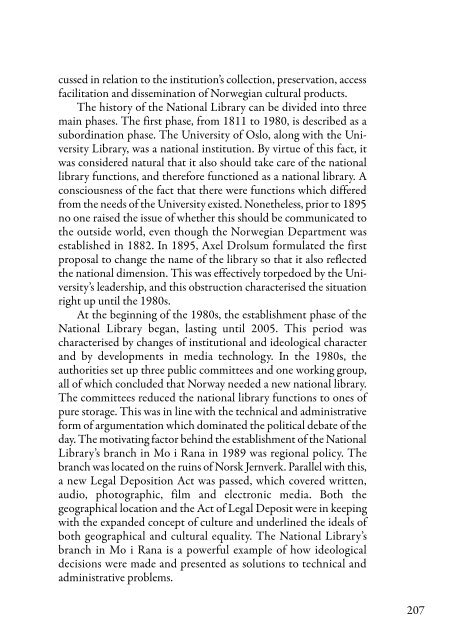Det nasjonale i Nasjonalbiblioteket
Det nasjonale i Nasjonalbiblioteket
Det nasjonale i Nasjonalbiblioteket
You also want an ePaper? Increase the reach of your titles
YUMPU automatically turns print PDFs into web optimized ePapers that Google loves.
cussed in relation to the institution’s collection, preservation, access<br />
facilitation and dissemination of Norwegian cultural products.<br />
The history of the National Library can be divided into three<br />
main phases. The first phase, from 1811 to 1980, is described as a<br />
subordination phase. The University of Oslo, along with the University<br />
Library, was a national institution. By virtue of this fact, it<br />
was considered natural that it also should take care of the national<br />
library functions, and therefore functioned as a national library. A<br />
consciousness of the fact that there were functions which differed<br />
from the needs of the University existed. Nonetheless, prior to 1895<br />
no one raised the issue of whether this should be communicated to<br />
the outside world, even though the Norwegian Department was<br />
established in 1882. In 1895, Axel Drolsum formulated the first<br />
proposal to change the name of the library so that it also reflected<br />
the national dimension. This was effectively torpedoed by the University’s<br />
leadership, and this obstruction characterised the situation<br />
right up until the 1980s.<br />
At the beginning of the 1980s, the establishment phase of the<br />
National Library began, lasting until 2005. This period was<br />
characterised by changes of institutional and ideological character<br />
and by developments in media technology. In the 1980s, the<br />
authorities set up three public committees and one working group,<br />
all of which concluded that Norway needed a new national library.<br />
The committees reduced the national library functions to ones of<br />
pure storage. This was in line with the technical and administrative<br />
form of argumentation which dominated the political debate of the<br />
day. The motivating factor behind the establishment of the National<br />
Library’s branch in Mo i Rana in 1989 was regional policy. The<br />
branch was located on the ruins of Norsk Jernverk. Parallel with this,<br />
a new Legal Deposition Act was passed, which covered written,<br />
audio, photographic, film and electronic media. Both the<br />
geographical location and the Act of Legal Deposit were in keeping<br />
with the expanded concept of culture and underlined the ideals of<br />
both geographical and cultural equality. The National Library’s<br />
branch in Mo i Rana is a powerful example of how ideological<br />
decisions were made and presented as solutions to technical and<br />
administrative problems.<br />
207




